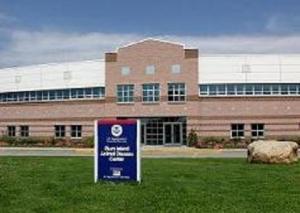BioterrorismScaled-back Kansas biolab would meet U.S. needs
A report by the National Research Council says that it is “imperative” that the United States build a large-animal biocontainment laboratory to protect animal and public health; two options are acceptable: a $1.4 billion Biosafety Level 4 laboratory in Manhattan, Kansas, or a scaled-back Kansas lab tied to a distributed laboratory network in other facilities; a third option will not meet U.S. needs: maintaining current capabilities at Plum Island Animal Disease Center, because the Plum Island facilities do not meet current standards for high biocontainment

The Plum Island facility is not under consideration for continued use // Source: dhs.gov
It is “imperative” that the United States build a large-animal biocontainment laboratory to protect animal and public health, says a new report by the National Research Council. Two options that could meet long-term needs include the National Bio- and Agro-Defense Facility (NBAF) facility in Manhattan, Kansas, as currently designed, or a scaled-back version tied to a distributed laboratory network.
Until such a facility opens which is authorized to work with highly contagious foot-and-mouth disease, the Plum Island Animal Disease Center located off Long Island should remain in operation to address ongoing needs.
A National Academy of Science release notes that the report concludes that there are important drawbacks for the United States, should it rely solely on international laboratories to meet large animal Biosafety Level 4 needs in the long term.
The proposed NBAF in Manhattan, Kansas, would be the world’s fourth Biosafety Level 4 laboratory capable of large animal research and would replace the aging Plum Island facility. NBAF would study highly contagious foreign animal diseases — including foot-and-mouth disease, which affects cattle, pigs, deer, and other cloven-hoofed animals — as well as emerging and new diseases that can be transmitted between animals and people.
Given the estimated cost of $1.14 billion to construct NBAF at the proposed site and the country’s current fiscal challenges, the DHS requested that the National Research Council analyze whether three options could meet the nation’s laboratory infrastructure needs.
The three options as stipulated by DHS were: constructing NBAF as designed, constructing a “scaled-back” version of NBAF, and maintaining current capabilities at Plum Island Animal Disease Center.
Because the Plum Island facilities do not have large animal Biosafety Level 4 capacity — containment of agents that are potentially life-threatening to humans and pose a high risk of transmission — this type of work would have to be conducted at foreign laboratories.
The scope of the committee’s analysis was limited to examining the three options and explicitly excluded an assessment of specific site locations for the proposed laboratory facility. Therefore, the report neither compares relative risks of the three options nor determines where foot-and-mouth disease research can be safely conducted. In addition, the committee concluded that to fill laboratory needs most appropriately, all factors of concern will need to be considered in a more comprehensive assessment.
The report concludes that DHS’ first option — NBAF as currently designed — includes all components of the ideal laboratory infrastructure in a single location and has been designed to meet the current and anticipated future mission needs of DHS and the U.S. Department of Agriculture’s Agricultural Research Service and Animal and Plant Health Inspection Service.
The proposed facility also has drawbacks, however, including substantial costs associated with construction, operation, and management; and not leveraging existing capacity at other containment laboratories in the United States.
Regarding the second option, the report finds that a partnership between a central national laboratory of reduced scope and size and a distributed laboratory network can effectively protect the United States from foreign animal and zoonotic diseases, potentially realize cost savings, reduce redundancies while increasing efficiencies, and enhance the cohesiveness of a national system of biocontainment laboratories. The cost implications of reducing the scope and capacity of a central facility are not known.
In its assessment of the third option, the report says that maintaining the Plum Island Animal Disease Center and leveraging foreign laboratories for large animal Biosafety Level 4 needs would avoid the costs of constructing a new replacement facility. The facilities at Plum Island, however, do not meet current standards for high biocontainment. Given the uncertainty over priorities of a foreign laboratory and logistical difficulties in an emergency, it would not be desirable for the United States to rely on international laboratories to meet these needs in the long term.
The report adds that because foot-and-mouth disease research remains critical for the U.S. animal health system, it will be essential to maintain the Plum Island facility until an alternative facility is authorized, constructed, commissioned, and approved for work with the virus.
Regardless of the options considered for a central facility, the report recommends that DHS and USDA develop and implement an integrated national strategy that utilizes a distributed system for addressing foreign animal and zoonotic disease threats. The capital costs associated with maintaining or constructing modern laboratory facilities should be balanced with the need to support research priorities. Therefore, it is critical for DHS and USDA to develop solutions that strike a balance between facilities costs and the research and development effort needed to protect American agriculture and public health.
— Read more in Meeting Critical Laboratory Needs for Animal Agriculture: Examination of Three Options (National Academies Press, 2012)
